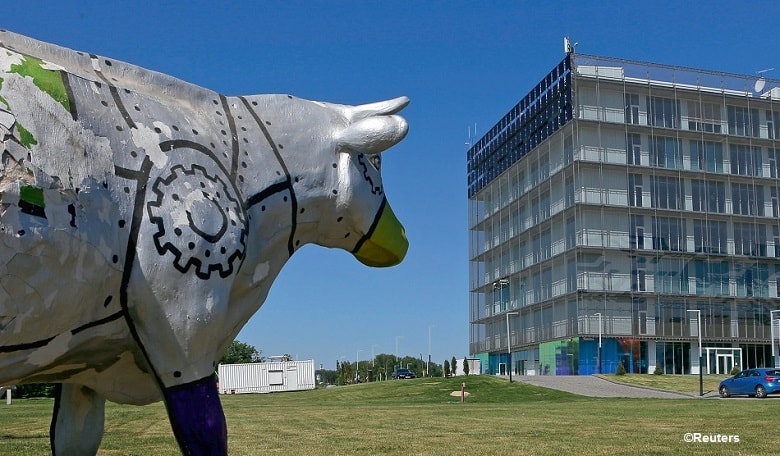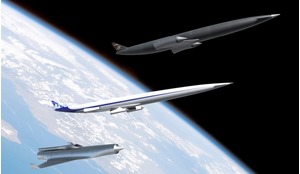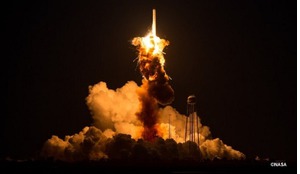As little as 10 years ago, the idea of a private astronautics sector in Russia was the stuff of fantasy. At Roscosmos board meetings, general managers insisted that space exploration was a state matter. Only rare heretics like Nikolai Sevastyanov dared to rock the boat. “Astronautics can be profitable,” declared the young manager of RSC Energia. A skeptical audience sneered. And yet, he was right.
In the early 2000s, commercialisation of near-Earth space was certainly on NASA’s and the European Space Agency’s agenda. Within a few years, a new generation of commercial companies appeared: enterprises currently classified as ‘Space 2.0’. Richard Branson, founder of Virgin Galactic, began openly speaking about his plans of turning a profit on suborbital tourism. Space startups mushroomed in the Mojave Desert. SpaceX, founded by Elon Musk, became a world-famous company.
Until July 2011, when the Skolkovo space cluster was created, the Russian space industry was almost entirely comprised of state-run enterprises. The few private astronautics companies that did exist included Gazprom Space Systems, a communications satellite and Earth remote sensing (ERS) operator; Sovzond and Skaneks, providing ground-based ERS services; NIS GLONASS, a navigational services and equipment provider; plus a few companies offering launch services, such as Kosmotras.
In just over three years, the situation has changed drastically. Already, a few dozen space startups with various specialties have appeared, from component suppliers to small space vehicle manufacturers, from software providers to specialists in communications, ERS and navigation. These young companies follow Space 2.0 principles. They are answering market demand, and foregoing traditional cooperation in favour of independent execution of work. Proof that this new model can deliver is in the four working small satellites that were created using the newest approaches to space vehicle design and engineering.
Most of these new-wave companies are residents of the Skolkovo space cluster, a new institute for the development of space exploration as part of the Skolkovo Innovative Center. One such company taking advantage of the space cluster is Dauria Aerospace. Founder and president Mikhail Kokorich was inspired to create the company after meeting the lateRoscosmos director Vladimir Popovkin at the International Astronautical Congress in Capetown in 2011. After obtaining a licence for space production, by the end of 2012, Dauria had won a tender worth RUB 310 million for creating two small space vehicles for Roscosmos.
In 2014, the company built the DX1 satellite for Russia and two Perseus-M micro-satellites in the US. All three were launched this summer. These maritime surveillance satellites provide automatic ship identification, but also serve to work out technical solutions that, in many ways, will determine the next generation of satellites. Future projects include a high-resolution ERS, produced in cooperation with one of the largest players in the Russian geo-information services market.
It is no accident that Kokorich chose Skolkovo as the location for Dauria’s major subdivisions. Firstly, the technology park is located close to Moscow. In 2012, Dauria became Skolkovo’s partner and agreed to build a 15,000 square metre Research and Advanced Development Center. The government is providing the land for a nominal fee, and communication lines will be free. Skolkovo also helps companies with tax and customs fee breaks. But the most important thing is the ecosystem it provides, an environment of like-minded people. The space cluster has become an important centre for communication between professionals who are concerned with the development of the space industry overall, and the private space sector in particular.
Another private company enjoying the benefits of locating within Skolkovo is Sputnix. On 20 June 2014 it launched its micro satellite, TabletSat-Aurora. Weighing in at only 26 kg, the satellite nonetheless boasts a good power supply capacity due to a solar panel system (a strict launch deadline set by Kosmotras forced the developers to forego the original plan to build a full-scale commercial vehicle). The novelty of the project is that Sputnix is developing what might be called ‘LEGO ideology’. On-board systems connect to the central bus in just the same way as modern plug and play computers. All of the platform’s service systems include a common service interface, which allows the satellites to be constructed from standardised blocks.
Sputnix hopes that TabletSat-Aurora will become a universal platform for the installation of scientific and applied useful loads and, possibly, for solving low-orbit communications issues. The company plans on creating a high-resolution (1 metre/pixel) small space vehicle constellation.
Spectralaser, founded by entrepreneurs Dmitry Tsetlin and Sergey Rebrov, creates laser modules for rocket engine ignition systems. The company received a Skolkovo grant and was able to provide successful training for an entire line of liquid-fuelled rocket engines. Tsetlin hopes that his models will help light all 64 steering and cruising thrust chambers of the Soyuz-2 rocket, due to launch from Vostochny cosmodrome in 2016. The work is being done in close cooperation with several industrial partners: Keldysh Center, NPO Energomash, Chemautomatic CB, CSCB Progress and Kuznetsov SRTC.
Other new residents of the Skolkovo space cluster include New Energy Technologies, which develops small-scale atomic clocks for space and Earth use; Azmerit, which provides innovative solutions in small-scale star tracking devices for attitude control of micro satellites; and Lin Industrial, which is working to create an ultra lightweight rocket that could drastically reduce the costs of blasting into orbit.
The space cluster’s staff, as well as the expert strategist group that has formed around them, have done a great job. The board of experts, for example, provides a valuable role in evaluating projects, essential for quality selection. In July 2011, the cluster’s Club of Friends was formed and continues to meet regularly. The cluster continues to be supported by the Consulting Academic Council of Skolkovo Foundation and its space section.
Top right: Spectralaser received a Skolkovo Foundation grant to enable the testing phase of laser modules for rocket engine ignition systems. Below right: Lin Industrial is in the early stages of creating a family of light launch rockets
The cluster’s team set a goal for itself: to lay the groundwork for private astronautics in Russia. Three directions were established: space to Earth, Earth to space and new industrial technologies. Foresight research was conducted in cooperation with the Space Research Institute at the Russian Academy of Sciences. A cooperation agreement was signed with Roscosmos and a number of leading industry enterprises and institutions. Immediately after the United Rocket and Space Corporation was founded, methodical work with the Corporation’s specialists began, including work on introducing Skolkovo residents to industry enterprises.
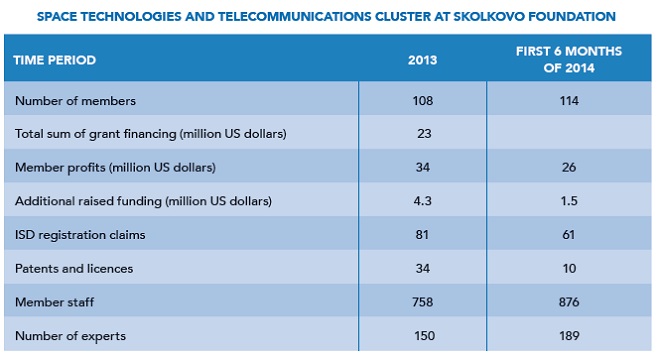
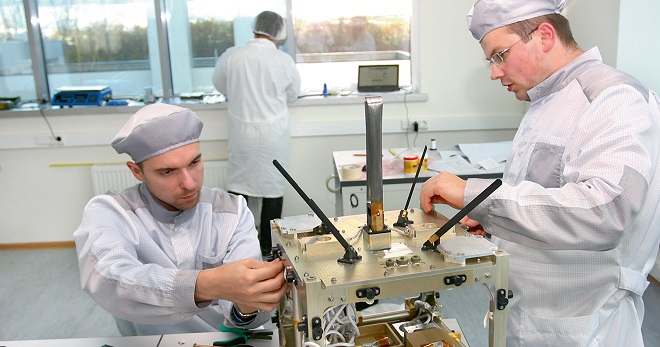 The Dauria Aerospace team building a CubeSat
The Dauria Aerospace team building a CubeSat
To date, the total amount of approved grants to Skolkovo residents is approximately RUB 700 million. A few hundred million rubles were also raised as co-financing for grants. These efforts have borne fruit. Today, Skolkovo’s space cluster is home to 117 resident companies. The combined profits for cluster companies was US$34 million in 2013, and already US$26 million in the first half of 2014.
Great potential
Industry reforms are making possible things one didn’t dare dream of in the past, and can objectively help the development of private astronautics. There is hope that the dissociation of Roscosmos and manufacturing, which is forcing the space agency to take a closer look at the development of competition and innovations in the industry, will in the medium term lead to positive results.
In other words, to achieve the most effective means of production, Roscosmos is able to contract outside of traditional manufacturing and development, forcing it to compete with new players.
There is clearly great potential for the private astronautics sector in Russia. Yet many obstacles remain in the way of aspiring companies. Laws regulating commercial space activity remain a barrier to entry. It’s not easy for a startup to get licensed to work in astronautics. Recent sanctions have added to the already existing difficulties in export control. Excessive secrecy is also an unresolved problem. And there still aren’t enough success stories to convince potential private investors to part with their cash.
Private astronautics is supported by the professional community, and that’s a good sign. It is a community of extraordinary, driven people. “Of course, Russian private astronautics is nowhere near the US or Europe,” writes the blogger Zelenyikot. “We need large investors, government contracts, the public’s trust. But regardless of the difficulties, the groundwork’s been laid.”
The authors thank Vladimir Gerzhenzon, Ivan Kosenkov, and Dmitry Tsetlin for the discussion and valuable comments, and Vitaly Egorov and Daria Kurguzova for help with collecting materials for the article.
References
1 Sergey Zhukov. We Raise One Elephant Every Three Years. Sergey Zhukov’s blog on Skolkovo website, June 24, 2013 (http://community.sk.ru/foundation/space/b/zhukov/archive/2013/07/24/my-rastim-odnogo-slona-raz-v-tri-goda.aspx).
2 Andrey G. Ionin “The end of an era”. ROOM No 1-2014, p. 22-27.
3 Natalia Savisko. Space Benefit. Izvestiya, June 25, 2014. (http://izvestia.ru/news/574379).
4 Vitaly Egorov. Answer to Yu. Latynina about private astronautics in Russia and in general. Blog http://zelenyikot.livejournal.com/, Sept. 23, 2014 (http://zelenyikot.livejournal.com/49055.html).





